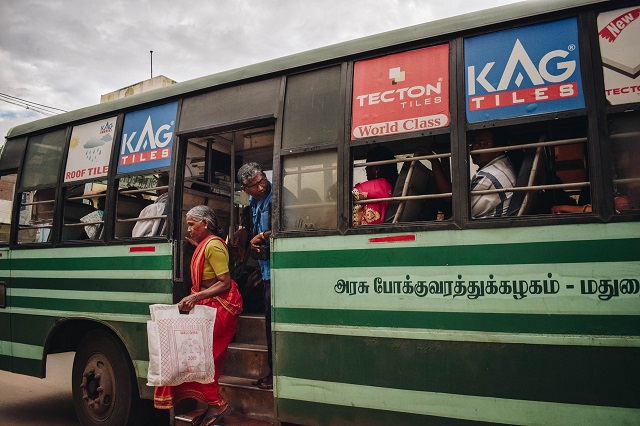
The COVID-19 pandemic has highlighted public transportation as an essential service for the functioning of all cities. But especially for many women, the closures and general instability of public transit systems have meant loss of access to services and customers they rely on every day. In general, women tend to rely on public transportation more than any other household member, from buying food to attending to childcare to employment.
Part of the problem, though, is how little we know about the differences between how men and women use transport. Traditional planning practices measure broad origin and destination pairs, and the process severely underrepresents the mobility requirements of women. Lack of more detailed data impedes transport systems’ ability to measure, anticipate and respond to women’s unique needs, putting them at a greater risk of reduced access to mobility and other disparities, as research has shown.
As the global transport sector looks to rebound from COVID-related shutdowns, a data-driven understanding of mode choices can inform the direction of future investments and policies for low-carbon transport options. Understanding distinct, complex mobility patterns and subsequent solutions by gender can lead to higher levels of public transit usage and safer walking and cycling.
Public transit agencies in Indian cities are increasingly using Intelligent Transport Systems, digital ticketing and mobile applications to improve operations and deliver better services. Smartphones, social media platforms and machine learning also hold myriad abilities to bridge the gap in gendered mobility data and enable better service provision for women and operational capacity for transit agencies generally. However, very little is being done to utilize these tools.
Below are examples from Delhi on existing gaps in women’s mobility data and how specific technologies can help bridge them.
Digital Ticketing
In February 2021, as a precautionary measure to avoid the spread of COVID-19, the Delhi Transport Corporation (DTC) commenced the final trial of a new app, Chartr, that allows commuters to book bus tickets through their smartphones. Cash has been the traditional means of transaction between commuters and transit systems in India. But as people started warming up to purchasing tickets through the app, DTC observed that the largest uptake of digital ticketing was from women – about 67%. (Since October 2019, all bus tickets are free for women in Delhi, as a way to boost safety and ridership, but they can still reserve their tickets using the app.)
The uptake highlights an important observation: given the right technology, women may adopt digital transit transactions quite quickly.
The digital ticketing interface is not only easier for many people, it now provides DTC with a way to capture more detailed spatial and temporal mobility patterns of commuters than a simple cash transaction, since they can collect gendered data of users and associate with usage of the system. Analysis of daily, weekly and monthly data from the app could inform DTC’s decisions on routes, schedules and frequencies that better cater to women commuters, and create a much more detailed understanding of the impact of different policy changes too.
Safety and Security Reporting
In 2018, a female student from Delhi narrated a harrowing encounter with sexual harassment in a crowded bus on Route 544. The tweet soon gathered popularity as more women and students narrated similar experiences on the same bus route. The route was recognized to be notorious for organized and systematic attempts by men to take the advantage of crowds to inappropriately touch women, with documented episodes going back as far as 1985. The outrage led authorities to launch a women-only bus for the route. But there is a need for more systematic measures to counter harassment.
Other cities have experimented with smartphone applications that make it easier for women to report sexual harassment. Machine Learning algorithms can also be equipped to capture keywords, hashtags and other information from Twitter and other social media platforms to automatically identify specific areas of transit infrastructure or services that are the biggest problems. These methods of gathering perception and incident data can supplement traditional incident reports because they can cover a much broader range of interactions. The data can then be used to inform targeted measures to adapt services or operations – hopefully earlier than in the case of the Route 544 bus.
Closing the Gap on Gender-Blind Planning
The two examples demonstrate the need for a closer investigation into how cities can utilize digitization, social media footprints and other such technologies to address two of the biggest challenges that are typical of gender and mobility: the void in gender-sensitive data collection and data-informed planning, and safety and security.
However, gender-disaggregated mobility data is being collected every day in every city around the world, through mobile phones, geospatial data and the digital trail of social media. We need more creative approaches to putting it to good use.
Indeed, mobility data is intersectional and can be used to plan for more inclusive transport and improve operational efficiency for everyone. As other Indian cities digitize their public transit systems, incorporating a gender lens is vital to cater to the unique needs of all transport system users, across gender, age, income, ethnicity and geography.
Harshita Jamba is a Project Associate at WRI India Ross Center for Sustainable Cities.
Vishal Ramprasad is a Manager for Integrated Transport at WRI India Ross Center for Sustainable Cities.






